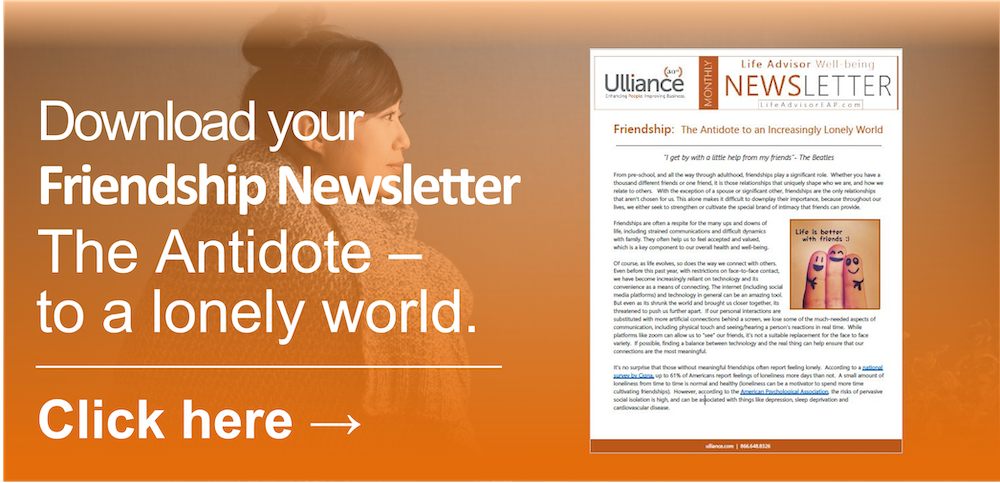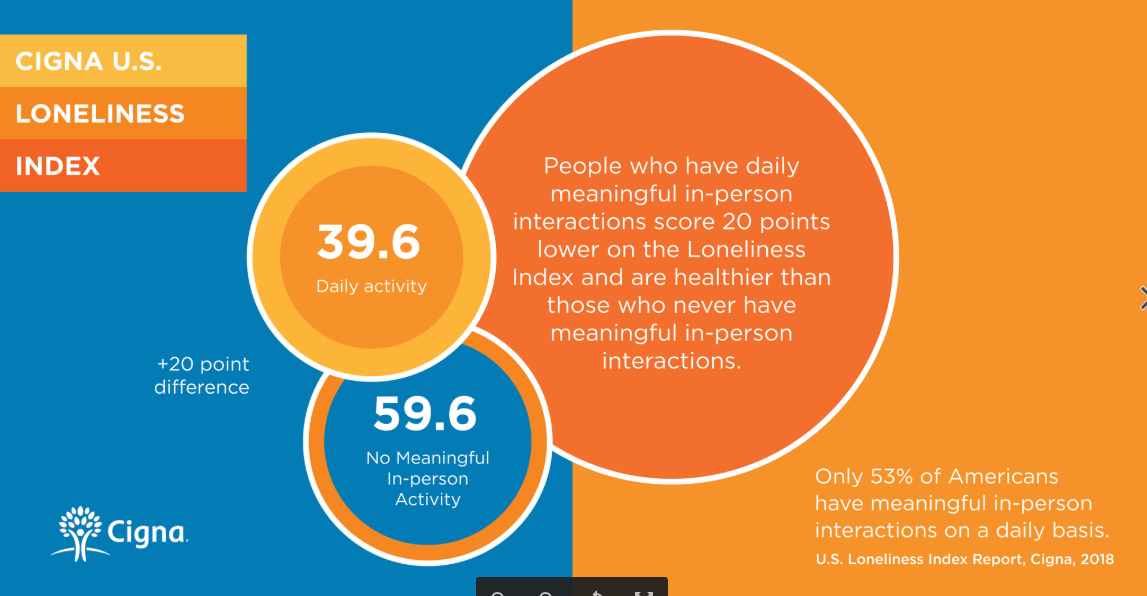Have you spent time alone during the pandemic? You may be tired of hearing about COVID and its effects on people, but, if nothing else, it has given us many talking points.
Researchers are having a field day testing, analyzing, correlating, and comparing people's lives before, during, and after the pandemic. Surveys and tests and a multitude of assessments have been developed and dispersed among the population. The results are continuously the topic of a new article published everywhere. It may seem redundant, but the information is valuable and has led to some solutions for problems that didn't exist before.
Loneliness by the Numbers
-
In 2018, almost half of Americans reported sometimes or constantly feeling alone. Recent studies suggest that during the pandemic, over one in three Americans face "serious loneliness."
-
Most recently, psychologists have expressed concern that loneliness is rising to new levels. Studies, like the one done in the UK that led to the Campaign to End Loneliness, have shown for years that as people age, they suffer from loneliness more than other populations and generations. Chronic illness, grieving the death of loved ones, difficulty with everyday tasks, and lack of social gatherings are the most common reasons for loneliness in people over 65.
-
But feeling lonely is no longer reserved for your later years. The Making Caring Common Project reported on a study indicating loneliness has increased substantially since the pandemic and that 36% of Americans feel "serious loneliness," with 61% of them being young adults.
-
Noreena Hertz, author of ‘The Lonely Century,’ states that even before the pandemic 1 in 5 Americans are lonely often or always and 1 in 5 millennials do not have a single friend and during the pandemic the loneliness levels went off the chart.
-
The Stanford Social Innovation Review reports that a quarter of people over age 60 live alone, and 43 percent of them reported feeling lonely even before COVID. But surprisingly, it was 18 – 22 year old's that had the highest loneliness scores, many of whom had never experienced the feeling before.
Loneliness often leads to chronic illnesses, including depression and physical pain, but new awareness brings new solutions. People can become social again.
Technology has given us the tools to rebuild connections, and old-fashioned conversation at the coffee shop is still a friendship builder. It's time to get creative and find new ways to ease social isolation in the population.
Does Being Alone Mean You Are Lonely?
Not necessarily.
Three Dog Night pointed out that "one is the loneliest number that you'll ever do" in 1969, and though some may agree, others don't find it lonely at all.
Being alone is a physical state where you are physically by yourself. Loneliness is an emotion. It happens when the social connection you want doesn't match your relationship experience with others.
Many people like the solitude they find when they spend time alone and prefer to spend most of their time with themselves. Even so, solitude can lead to loneliness over time.
Humans need real, heartfelt connections with other people to survive and thrive. When a person doesn't have a kindred spirit to laugh with or confide in, they begin to wither away just like the plant you forgot to water.
During the pandemic, spending time alone was rarely by choice. It was by necessity and caused significant stress and hardship among the elderly and young people.
Some people don't recognize the signs of loneliness and stay isolated because it's what they have come to know.
Symptoms of loneliness include:
• The inability to connect with others on a deeper level. The small talk with the mailman or the friendly hello to the neighbor is not a connection.
• Lack of a close friend, someone you trust, confide in and laugh with
• Feeling isolated regardless of who is around you
• Feeling alienated and disengaged from everyone and like others are avoiding you
• Negative thoughts about your life and feelings of self-doubt or worthlessness
• Feeling invisible, when you reach out to connect with someone, and it is not reciprocated
• Exhaustion when you try to engage socially
• Getting ill more often or generally feeling unwell
So, to answer the question, no, being alone does not mean you are lonely. You are lonely when you are socially isolated and lack the desired connection or attachment to another person.
"I used to think the worst thing in life was to end up alone. It's not. The worst thing in life is to end up with people that make you feel alone."
Robin Williams
The Workplace and Loneliness
As an HR professional, if you notice that employees seem more withdrawn than they were pre-pandemic this may be a sign that you really need to start promoting the use of your organizations EAP.
At Ulliance, our EAP Account Managers have a mental health background and can help HR professionals gain valuable insight about any concerns they have about an employee’s emotional well-being. Ulliance Account Managers can also help with appropriate next steps, including advice on talking with your employee, or making a referral to your Employee Assistance Program.
Loneliness Shouldn't be Anyone's Story
There are several reasons people may feel lonely, and the solution may differ by type and person.
- Many people who make big life changes like moving to a new city experience loneliness, and what works for them may be different from what works for the young man feeling lonely because he doesn't have a romantic partner.
- Feeling different from everyone else or having friends who are untrustworthy or make little effort to attend events you invite them to are other causes of loneliness.
- It is important to know why you feel lonely, so you can apply the right solution, which involves finding a way to connect with another person. Social groups that focus on projects or crafting are good options. Joining a Bible study or a hunting party, or a book club are good places to find people with similar interests.
- Organizations that partner with local governments to identify at-risk groups are staffed with volunteers who go out into the community and offer companionship to isolated individuals.
- Another solution gaining popularity is pairing young adults suffering from loneliness with an older person with similar interests.
Fighting loneliness is almost impossible to do when you are the lonely person. And the stigma attached to loneliness often makes people feel hopeless and ashamed, which prevents them from reaching out for help.
Learning to recognize the signs of loneliness, especially in at-risk populations allows you to build a mutually beneficial, connected relationship with another person and have a lasting impact on both your lives.
Building connections takes effort and courage and is not always easy to do.
But the gift of a lasting friendship based on mutual interests and shared
experiences makes the effort worthwhile.
When you partner with Ulliance, our Life Advisor Consultants are always just a phone call away to teach ways to enhance your work/life balance and increase your happiness. The Ulliance Life Advisor Employee Assistance Program (a total Well-being Program) can help employees and employers come closer to a state of total well-being.
References:
Laughter really could be the best medicine. (n.d.). Retrieved from Campaign ti End Loneliness: https://www.campaigntoendloneliness.org/laughter-really-could-be-the-best-medicine/
Loneliness in America: How the Pandemic Has Deepened an Epidemic of Loneliness and What We Can Do About It. (2021, February). Retrieved from Making Caring Common: https://mcc.gse.harvard.edu/reports/loneliness-in-america
Madeline Dangerfield Cha and Joy Zhang. (2021, March 29). Solving the Loneliness Epidemic, Two Generations at a Time. Retrieved from Stanford Social Innovation Review: https://ssir.org/articles/entry/solving_the_loneliness_epidemic_two_generations_at_a_time
Rubin, G. (2017, February 27). 7 Types of Loneliness and Why it Mastters. Retrieved from Psychology Today: https://www.psychologytoday.com/us/blog/the-happiness-project/201702/7-types-loneliness-and-why-it-matters
Sundberg, N. (2020, July 29). Alone but Not Lonrely: How to Build Connections and Feel Less Lonely. Retrieved from Headway: https://headway.ginger.io/alone-but-not-lonely-how-to-build-connections-and-feel-less-lonely-fadaefcbcd08




